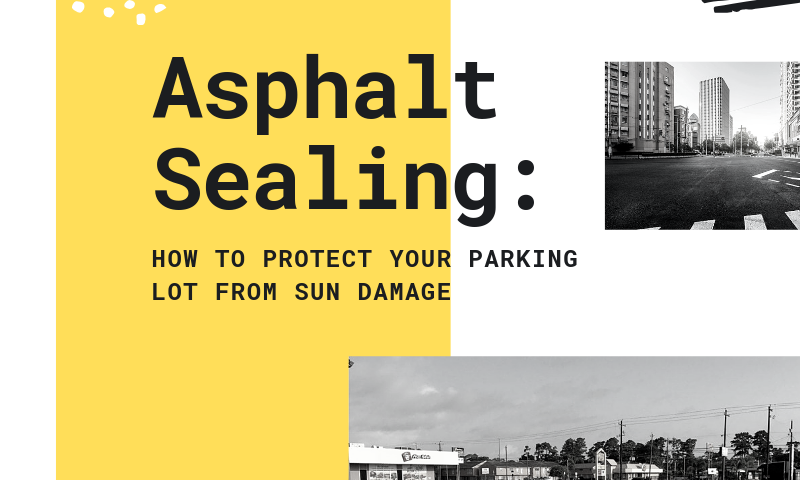
Asphalt Sealing: How to protect your parking lot from sun damage
Asphalt parking lots are great if you’re looking for something relatively affordable and easy to install, but keeping them pristine means doing what you can to block out the sun. During the hottest months of summer, the hot sun beating down on the asphalt can take quite a toll. If you’re looking for a way to better protect your asphalt parking lot, check out these five tips.
1. Basic coat
The easiest thing you can do if you want to protect your parking lot from sun damage is to apply a standard asphalt sealing coat. These sealing coats come in all sorts of different varieties, but they’re all designed to protect your parking lot from damage due to the sun, water or rock pitting. Keep in mind that the type of coat you choose will determine the quality of your seal, so it’s important to choose the right one if protection is a priority. This coat should be applied once a year.
2. Slurry Sealer
Standard asphalt sealing coats are good when it comes to providing some protection, but they don’t do a lot to change the actual texture of your parking lot. Slurry sealers are designed with lots of aggregate in the sealer, which means crackes and holes in your asphalt parking lot are filled while the asphalt is sealed to keep out UV rays and water. However, these seals require about 24 hours to dry and cure, so you need to have some time on your hands.
3. Microsurfacing
Microsurfacing is another popular choice when it comes to sealing asphalt parking lots. This is essentially a type of slurry seal that’s designed to set a lot quicker, which means you don’t have to keep traffic off your asphalt as long. This is an expensive option but a good one if you’re looking for a way to put a solid seal on a high-traffic area.
4. TRMSS
This isn’t the most popular type of sealer for residential and light commercial use, but tire rubber modified surface sealer is great if you need a strong seal for areas that consistently get heavy traffic. This rubberized sealer does a great job of replenishing the oils your asphalt parking lot needs while spreading aggregate to help fill cracks and small holes. TRMSS is most often used for things like streets and airport runways.
5. Fill Cracks
While your asphalt parking lot is always going to have some level of exposure to the sun, you can seriously cut down on the effect that exposure has by filling the cracks and holes in your parking lot regularly. Make sure you’re keeping an eye on your asphalt so you can be aware of damage right when it happens and get it fixed right away. While this won’t replace a good sealer, filling the cracks in your parking lot is crucial.
As great as asphalt parking lots are, they require a bit of upkeep if you really want to get the most out of them. The good news is, taking the time to seal and repair your parking lot when it’s needed will prevent damage from UV rays, water and rock pitting and will keep your lot looking great for years.
Asphalt parking lots are great if you’re looking for something relatively affordable and easy to install, but keeping them pristine means doing what you can to block out the sun. During the hottest months of summer, the hot sun beating down on the asphalt can take quite a toll. If you’re looking for a way to better protect your asphalt parking lot, check out these five tips.
1. Basic coat
The easiest thing you can do if you want to protect your parking lot from sun damage is to apply a standard asphalt sealing coat. These sealing coats come in all sorts of different varieties, but they’re all designed to protect your parking lot from damage due to the sun, water or rock pitting. Keep in mind that the type of coat you choose will determine the quality of your seal, so it’s important to choose the right one if protection is a priority. This coat should be applied once a year.
2. Slurry Sealer
Standard asphalt sealing coats are good when it comes to providing some protection, but they don’t do a lot to change the actual texture of your parking lot. Slurry sealers are designed with lots of aggregate in the sealer, which means crackes and holes in your asphalt parking lot are filled while the asphalt is sealed to keep out UV rays and water. However, these seals require about 24 hours to dry and cure, so you need to have some time on your hands.
3. Microsurfacing
Microsurfacing is another popular choice when it comes to sealing asphalt parking lots. This is essentially a type of slurry seal that’s designed to set a lot quicker, which means you don’t have to keep traffic off your asphalt as long. This is an expensive option but a good one if you’re looking for a way to put a solid seal on a high-traffic area.
4. TRMSS
This isn’t the most popular type of sealer for residential and light commercial use, but tire rubber modified surface sealer is great if you need a strong seal for areas that consistently get heavy traffic. This rubberized sealer does a great job of replenishing the oils your asphalt parking lot needs while spreading aggregate to help fill cracks and small holes. TRMSS is most often used for things like streets and airport runways.
5. Fill Cracks
While your asphalt parking lot is always going to have some level of exposure to the sun, you can seriously cut down on the effect that exposure has by filling the cracks and holes in your parking lot regularly. Make sure you’re keeping an eye on your asphalt so you can be aware of damage right when it happens and get it fixed right away. While this won’t replace a good sealer, filling the cracks in your parking lot is crucial.
As great as asphalt parking lots are, they require a bit of upkeep if you really want to get the most out of them. The good news is, taking the time to seal and repair your parking lot when it’s needed will prevent damage from UV rays, water and rock pitting and will keep your lot looking great for years.




